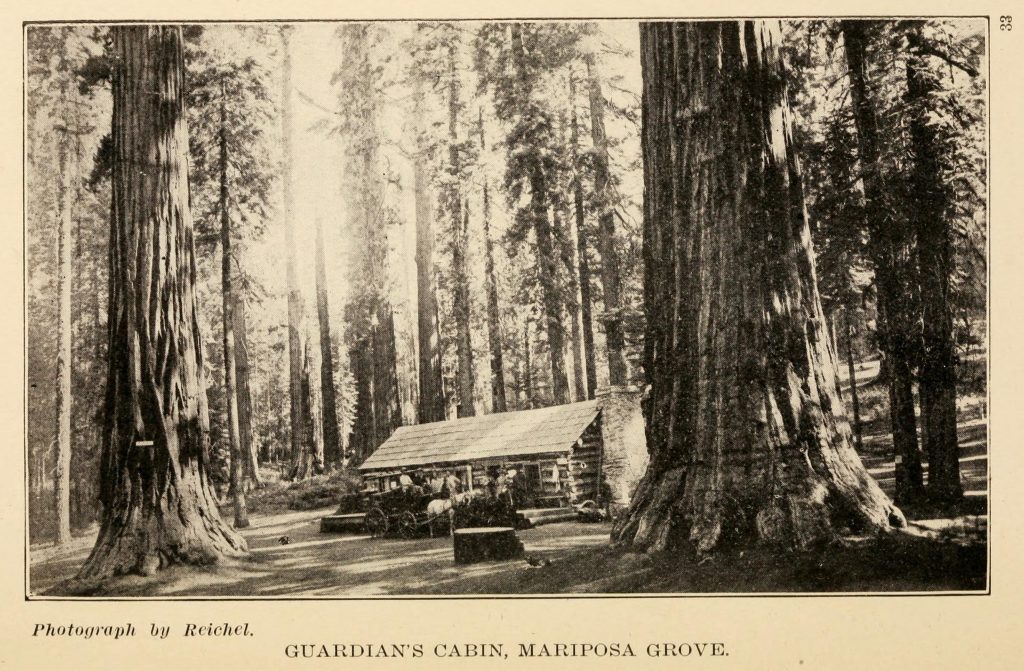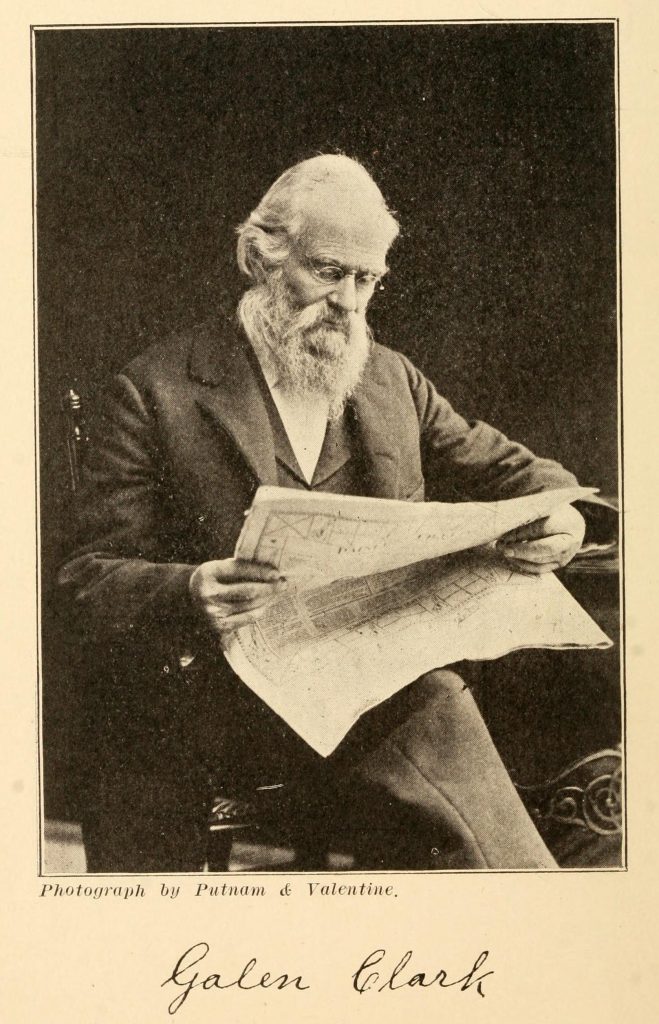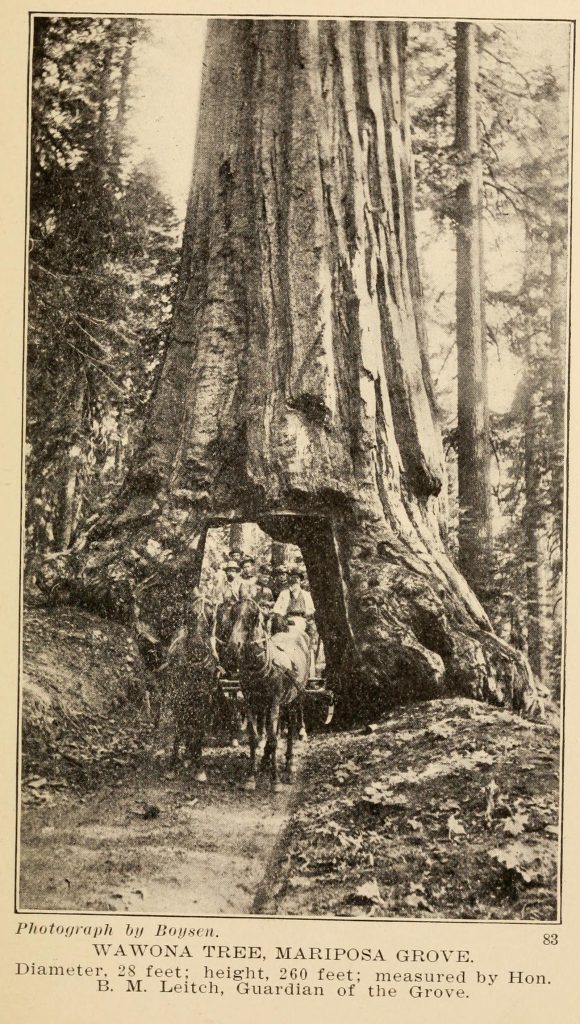Galen Clark: The Guardian of Yosemite
When Galen Clark’s The Big Trees of California, their History and Characteristics, was published, in 1907, he was 93 years old. It had been 50 years since he first came to live in the Mariposa Grove in Yosemite Valley. He had spent most of those years in the midst of the giant sequoias, serving as a guide and educator, and fighting for the protection of these natural wonders.

“Guardian’s Cabin. Mariposa Grove.” Clark, Galen. The big trees of California, their history and characteristics. 1907. Contributed in BHL from Library of Congress.
The noted naturalist and conservationist John Muir met Galen Clark on his first visit to Yosemite, and later, in his writing on The Yosemite, called him “the best mountaineer I ever met, and one of the kindest and most amiable of all my mountain friends.” Along with Muir, Clark was instrumental in Yosemite’s preservation and development as a national park.
Born in Canada 1814, Galen Clark migrated westward at an early age. In 1857, suffering from severe lung illness, he moved to Wawona, California for the mountain air. Although he engaged in several modest business enterprises, including running a hotel and serving as a professional guide, Clark was never successful as an entrepreneur. During much of his life he was consistently short of funds, but his accomplishments as an explorer and mountaineer, as well as his influence as a champion of forest and wilderness conservation, were widely recognized.
Galen Clark was an influential contributor to the original movement for the protection of Yosemite as a park. When President Abraham Lincoln signed the Yosemite Grant in 1864, setting aside the Mariposa Grove and Yosemite Valley as protected areas “for public use, resort, and recreation,” Clark was named the first Guardian of Yosemite. He served as Guardian for the next 24 years and lived to see Yosemite National Park established—as the third national park—in 1890. His influence and contributions were acknowledged when an iconic mountain peak was re-named Mt. Galen Clark in his honor.

Photo of Galen Clark. Clark, Galen. The big trees of California, their history and characteristics. 1907. Contributed in BHL from Library of Congress.
The Big Trees of California has a generous number of full-page photographs, including some taken by the Yosemite photographer George Fiske. Many of the bigger named trees are included, and there are also images of the Guardian’s Cabin nestled in the Mariposa Grove, and of the Wawona hotel (now Big Trees Lodge).
Within the free-flowing border of green foliage and cones that decorates each page of text, Clark touches on most aspects of the history, biology, and geography of these fantastic trees. He discusses cones and seeds, and gives tips for testing seed viability. He also provides an overview of the distribution of big trees in California’s other major sequoia groves—although his main focus is on the Mariposa Grove.
In discussing the sequoia’s origins, Clark shares his awe for this “ancient order of forest trees … contemporaneous with such huge animals as the dinotherium, megatherium mammoth, and monster reptiles long since extinct.” Clark talks about the difficulties of determining the age of any particular sequoia—as even fallen trees, where the rings are easily examined, exhibit many irregularities and variations in ring growth. However, he does speculate that some of the older trees may have been at least several thousands of years old.
Galen Clark’s love of the giant trees consistently shines through in this book. Despite the inclusion of a number of strictly factual portions—such as a detailed chemical analysis of the gum from a sequoia cone, along with a report supplied by supplied by Professor H. W. Wiley, Chief of the Bureau of Chemistry at the United States Department of Agriculture—this book comes across as an ode to the sequoias. In the section on “Habits and Characteristics,” for example, Clark sets out to provide some strictly factual botanical descriptions of branching and leaf types, but soon segues into a lyrical description:
The bright cinnamon color of their immense fluted trunks, in strong contrast to the green foliage, and dark hues of the surrounding forest makes them all the more conspicuous and impressive. In their sublime presence, a person is apt to be filled with a sense of awe and veneration as if treading on hallowed ground.

“Wawona Tree, Mariposa Grove.” Clark, Galen. The big trees of California, their history and characteristics. 1907. Contributed in BHL from Library of Congress.
A highlight of the book is the listing and description of some of the biggest of the big trees in California–and it is good to know that, more than 100 years later, many of his “celebrated specimens” are still standing.
The General Sherman Tree: This giant is still standing and has earned the title of World’s Largest Tree (by volume). It stands 275 feet (83m) tall and is over 36 feet (11m) in diameter at its base. It is now estimated that this tree is somewhere around 2,000 years old.
The Grizzly Giant: Clark names this old sequoia “the Patriarch of the Mariposa Grove.” He speculates that, despite the extensive damage it has sustained, the Grizzly Giant may be “not just the oldest living tree, but also the oldest living thing on earth.”
The General Grant Tree: Named after Ulysses S. Grant, this tree is slightly smaller than the General Sherman. In 1926, President Coolidge designated the General Grant as the Nation’s Christmas Tree, and annual ceremonies continue to be held at its base. This tree is also notable for being designated as a National Shrine by President Eisenhower, in 1956.
The Boole Tree: This tree was left standing alone in the Sanger Lumber Company’s logging camp after surrounding trees were cut for lumber, in about 1895. Clark predicted a swift death for this isolated and unprotected giant tree, but it still survives on what is now U.S. Forest Service land in Sequoia National Forest.
Sadly, another giant, the Mother of the Forest, in Calaveras Grove, was killed in the 1850s, when its bark was stripped and reassembled for display at various exhibitions in the United States and Europe. It was already dead, though not yet entirely destroyed by fire when The Big Trees of California was written.
Tunnel Trees: Clark writes that riding through the tunnel trees “in a six-horse stage, or any conveyance, is a great novelty and should not be missed.” The famous Wawona Tunnel Tree of Mariposa Grove was a favorite until it fell under a heavy load of snow in February 1969. Another tunnel tree, Pioneer Cabin, which Clark mentions briefly, came down during a winter storm in 2017.
Further Reading
The Boole Tree, from the USDA Forest Service
https://www.fs.usda.gov/recarea/sequoia/recarea/?recid=79961
Forest atlas of the national forests of the United States. Sequoia folio. By United States. Forest Service. Pinchot, Gifford, Smith, George Otis. Washington, D.C.: U.S. Department of Agriculture, Forest Service, 1909. DOI: https://doi.org/10.5962/bhl.title.119298.
Mariposa grove of big trees: a short history of the Mariposa big trees & the Yosemite Valley. By: Leitch, B. M. Wawona Calif: B.M. Leitch ?, 1910. DOI: https://doi.org/10.5962/bhl.title.30311.
Muir, John. South of Yosemite. Edited and with a foreword by Frederic R. Gunsky. Garden City, NY, Published for the American Museum of Natural History, by the Natural History Press, 1968.
Sequoia Research, Yosemite, from the National Park Service:
https://www.nps.gov/yose/learn/nature/sequoia-research.htm
Vischer’s views of California: the mammoth tree grove, Calaveras County, California, and its avenues. By: Vischer, Edward. San Francisco: Edward Vischer, 1862. DOI: https://doi.org/10.5962/bhl.title.50746.
Yosemite nature notes. United States. National Park Service. Yosemite Natural History Association, Yosemite Naturalist Department. Yosemite National Park Calif, Yosemite Natural History Association, 1922. Volume: 35 no.6. BHL: item/70374.





Leave a Comment